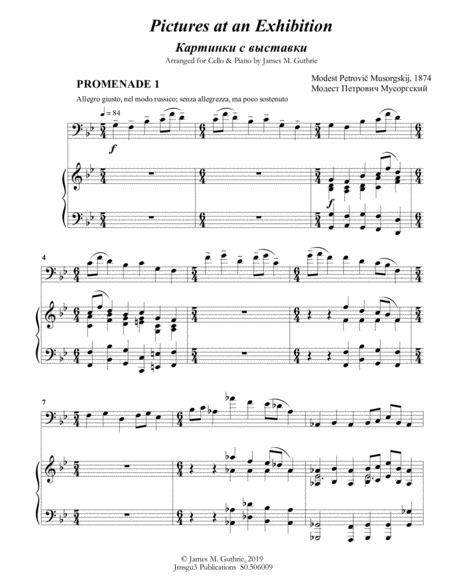Cello,Piano - Level 4 - Digital Download SKU: A0.549929 Composed by Modest MUSSORGSKY (1839 - 1881). Arranged by James M. Guthrie. Instructional,Romantic Period,Standards. Score and part. 91 pages. Jmsgu3 #4303415. Published by jmsgu3 (A0.549929). A classic selection of epic proportions. Score: 75 pages, Solo part: 16 pages, 924 measures. Duration: 34:30 Pictures at an Exhibition¬†(–ö–į—Ä—ā–ł–Ĺ–ļ–ł —Ā –≤—č—Ā—ā–į–≤–ļ–ł) by Modest Petrovińć Musorgskij, 1874 (–ú–ĺ–ī–Ķ—Ā—ā –ü–Ķ—ā—Ä–ĺ–≤–ł—á –ú—É—Ā–ĺ—Ä–≥—Ā–ļ–ł–Ļ) Promenade 1¬†¬†Allegro giusto, nel modo russico; senza allegrezza, ma poco sostenuto¬† ¬† page 1 1. GNOMUS¬†(The Gnome) ¬†Sempre vivo¬†page 4 Promenade 2¬†¬†Moderato commodo assai e con delicatezza¬†page 10 ¬†2. IL VECCHIO CASTELLO¬†(The Old Castle) Andante molto cantabile e con dolore¬†page 12 ¬†Promenade 3 Moderato non tanto, pesamente¬†page 18 ¬†3. TUILLERIES¬†Dispute d'enfants apr√®s jeux (Children's Quarrel after Games)¬†Allegretto non troppo, capriccioso¬†page 19 ¬† ¬† ¬† ¬† ¬† ¬† ¬† ¬† ¬† ¬† ¬† ¬† ¬† ¬† ¬† ¬† ¬† ¬† ¬† ¬† ¬† ¬† ¬† ¬† ¬† ¬† ¬† ¬† ¬† ¬† ¬† ¬† ¬† ¬† ¬† ¬† ¬† ¬† ¬†4. BYDLO¬†(Cattle) Sempre moderato pesante¬†¬†page 22 Promenade 4¬†Tranquillo¬†page 26 5. Ballet of the Unhatched Chicks¬†–Ď–į–Ľ–Ķ—ā –Ĺ–Ķ–≤—č–Ľ—É–Ņ–ł–≤—ą–ł—Ö—Ā—Ź –Ņ—ā–Ķ–Ĺ—Ü–ĺ–≤¬†Scherzino¬†¬†page 27 6. Samuel Goldenberg und Schmu√Ņle¬† –ē–≤—Ä–Ķ–Ļ –≤ –ľ–Ķ—Ö–ĺ–≤–ĺ–Ļ —ą–į–Ņ–ļ–Ķ. C–į–Ĺ–ī–ĺ–ľ–ł—Ä ¬†Andante¬†page 30 Promenade 5¬†¬†Allegro giusto, nel modo russico, poco sostenuto¬†page 36 7. LIMOGES.¬†LE MARCH√Č.¬†(La grande nouvelle) The Market (The Great News)¬†Allegretto vivo, sempre scherzando¬†¬† page 39 8. CATACOMBAE¬†(Sepulchrum romanum) (Roman Tomb) –ü–į—Ä–ł–∂—Ā–ļ–ł–Ķ –ļ–į—ā–į–ļ–ĺ–ľ–Ī—č ¬†Largo¬†page 46 ¬† ¬†CON MORTUIS IN LINGUA MORTUA¬†(With the Dead in a Dead Language)¬†Andante non¬†troppo, con lamento¬†page¬†47 9. The Hut on Hen's Legs¬†(Baba Yaga) –ė–∑–Ī—É—ą–ļ–į –Ď–į–Ī—č-–Į–≥–ł –Ĺ–į –ļ—É—Ä—Ć–ł—Ö –ĺ–∂–ļ–į—Ö. –ß–į—Ā—č –≤ —Ä—É—Ā—Ā–ļ–ĺ–ľ —Ā—ā–ł–Ľ–Ķ Allegro con brio, feroce¬†page 50 10. The Bogatyr Gates (In the Capital in Kiev) –ü—Ä–ĺ–Ķ–ļ—ā –≥–ĺ—Ä–ĺ–ī—Ā–ļ–ł—Ö –≤–ĺ—Ä–ĺ—ā –≤ –ö–ł–Ķ–≤–Ķ. –ď–Ľ–į–≤–Ĺ—č–Ļ —Ą–į—Ā–į–ī The Great Gates of Kiev Allegro alla breve Maestoso con grandezza¬†page 63Mussorgsky is known for his ability to evoke vivid pictures through his music. He creates soundscapes that transport listeners to other places and times. Through the use of complex harmonies and shifting tonalities, Mussorgsky creates sonic paintings that are as diverse and varied as any works of art in a museum. He takes listeners on a journey through different landscapes and environments, ranging from pastoral settings to the depths of the underworld. In his famous suite, Pictures at an Exhibition, Mussorgsky gives each movement a title that references a painting, sculpture, or architectural feature from an art museum. The suite is composed in such a way that it captures the moods and emotions evoked by the artworks. From the bright and energetic Promenade to the somber and mysterious Catacombs, Mussorgsky's Pictures at an Exhibition paints a vivid sonic landscape that brings the listener into the art museum.
